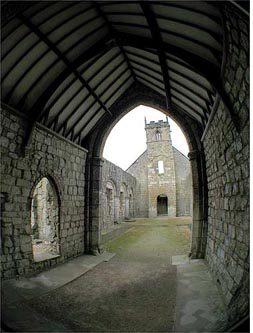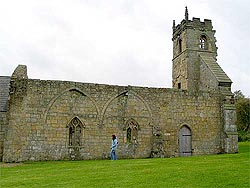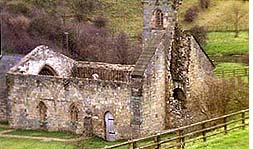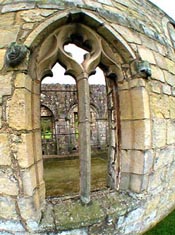Wharram Percy: The Town That Sheep Ate
by Dawn Copeman
 Wharram Percy was founded in the Bronze Age, occupied and remodeled by the Romans and lived in by Vikings, Anglo-Saxons and Normans. Yet, at some point in the 16th century, it was suddenly abandoned. And ever since the site was discovered in 1851 by Captain Bayly, who was surveying the area for the Ordnance Survey, people have been wondering why. Wharram Percy was founded in the Bronze Age, occupied and remodeled by the Romans and lived in by Vikings, Anglo-Saxons and Normans. Yet, at some point in the 16th century, it was suddenly abandoned. And ever since the site was discovered in 1851 by Captain Bayly, who was surveying the area for the Ordnance Survey, people have been wondering why.
Not that Wharram Percy is unique in being abandoned. Approximately 3000 medieval villages across England were deserted between the 11th and 18th centuries, including Purley Parva in Berkshire, Gainsthorpe in Lincolnshire and High Worsall in Yorkshire (which was excavated on British television in 1998). Wharram Percy is unique, however, in the amount of archaeological excavation it has undergone, work which began in 1952 and is still going on today.
At first it was thought that Wharram Percy might have been abandoned as a result of the Viking raids that had already laid waste to a third of the villages in Yorkshire, as recorded in the Doomsday book of 1086. But then archaeologists realised that the site had been in use long after this.
Maybe it was destroyed during William the Conqueror's Harrying of the North? But again, it was proved by physical and documentary evidence that the village escaped the Harrying unharmed.
 A village nearby had been raided by the Scottish, did that fate befall Wharram Percy? No, there's no evidence of it.
A village nearby had been raided by the Scottish, did that fate befall Wharram Percy? No, there's no evidence of it.
Perhaps it was the Black Death, then? Although the plague did kill several inhabitants of the village, including the priest and lord of the manor, the majority of the population survived.
So why was this village at the bottom of a valley deserted? Famine? Flooding? No. The reason was sheep. As Sir Thomas More wrote in Utopia, "Your sheep which are usually so tame and so cheaply fed, begin now, according to report, to be so greedy and wild that they devour human beings themselves and devastate and depopulate fields, houses, and towns."
Not that sheep were really eating humans, but you can see More's point. By the 15th century, sheep farming had become far more profitable than arable farming, so the lord of the manor turned more of his land into pasture land, leaving less for the farming of crops. This in turn led to less work and less food for the villagers of Wharram Percy, so that they were forced to leave the village to find work and food elsewhere. In the end, documentary evidence shows that there were just four homes left occupied when the landowner, Baron Hilton, evicted the few remaining villagers around 1517. Archaeologists think that the last inhabitant of Wharram Percy was either a vagrant or an inhabitant who refused to move out, who was killed when a dilapidated house collapsed on him whilst he slept.
To get to Wharram Percy you need to park at Bella's Farm. Follow the brown signs from the B1248 Beverley to Malton road, then follow a dirt track across fields for approximately three-quarters of a mile. For this reason and the fact that there is no shelter in the village, it's a good idea to visit the village in summer or on a dry day.
 As you walk down the side of the Wold -- that's the name for these high-sided hills -- you will see the ruins of the village church, St Martin's, in front of you, as well as the mill pond and a reconstructed house. Despite the depopulation of the village in the early 16th century, the church was still in use until 1870, when a new church was built in the nearby village of Thixendale. The church still had a roof and was in a good state of repair until 1949 when a robber stole the lead from the roof. In 1959 part of the tower collapsed in a storm and the church became a ruin -- albeit a ruin with a very fine door.
As you walk down the side of the Wold -- that's the name for these high-sided hills -- you will see the ruins of the village church, St Martin's, in front of you, as well as the mill pond and a reconstructed house. Despite the depopulation of the village in the early 16th century, the church was still in use until 1870, when a new church was built in the nearby village of Thixendale. The church still had a roof and was in a good state of repair until 1949 when a robber stole the lead from the roof. In 1959 part of the tower collapsed in a storm and the church became a ruin -- albeit a ruin with a very fine door.
St Martin's offered archaeologists a rare opportunity to excavate a church, and they found that it had grown and shrunk in concert with the population of the village. If you enter the church today, you can see the foundations of the earlier churches on the floor. The church was originally surrounded by glebe land -- land to be farmed by the parson.
The village had two water mills at the height of its occupancy, when it is thought to have had a population of around 150 to 180 people. The mill pond survived after the village was depopulated because it was stocked with fish for the lord of the manor.
 The reconstructed Norman manor house that is visible from the Wold was built in the 20th century. Excavations suggest that there were two Norman manor houses in the village. On one wall of the house is a sign saying "Wharram," which was taken from the nearby railway station in the 1940s, when all road and station signs across Britain were removed to confuse a possible German invasion force.
The reconstructed Norman manor house that is visible from the Wold was built in the 20th century. Excavations suggest that there were two Norman manor houses in the village. On one wall of the house is a sign saying "Wharram," which was taken from the nearby railway station in the 1940s, when all road and station signs across Britain were removed to confuse a possible German invasion force.
In the village itself you can see the outlines of 30 medieval peasants' houses. Each house had a toft and a croft, a toft being a small garden area for growing food and a croft being a larger parcel of land attached to each house for farming. The people lived in one half of the house and their animals in the other half. The houses were rebuilt on average every 50 years, sometimes larger or in a different orientation.
So come and have a look at the humps and bumps of Wharram Percy. See for yourself the fascinating results of the ongoing excavations. Be an archaeologist and try and guess what something was, then check the display boards to see if you're right. Just watch out for the sheep!
Wharram Percy is open all year round during daylight hours; admission is free.
More Information:
We regret that we no longer have the resources to maintain up-to-date links and/or hours and pricing details for the various sites and attractions listed on this website. For more information about the location(s) listed above, please use your favorite search engine or visit Wikipedia.
Dawn Copeman is a freelance writer and commercial writer who has had more than 100 articles published on travel, history, cookery, health and writing. She currently lives in Lincolnshire, where she is
working on her first fiction book. She started her career as a freelance
writer in 2004 and has been a contributing editor for several publications, including TimeTravel-Britain.com and Writing-World.com .
Article and Photo #3 (church from above) © 2005 Dawn Copeman
Additional photos courtesy of David Alcock of The Craven Image
| 